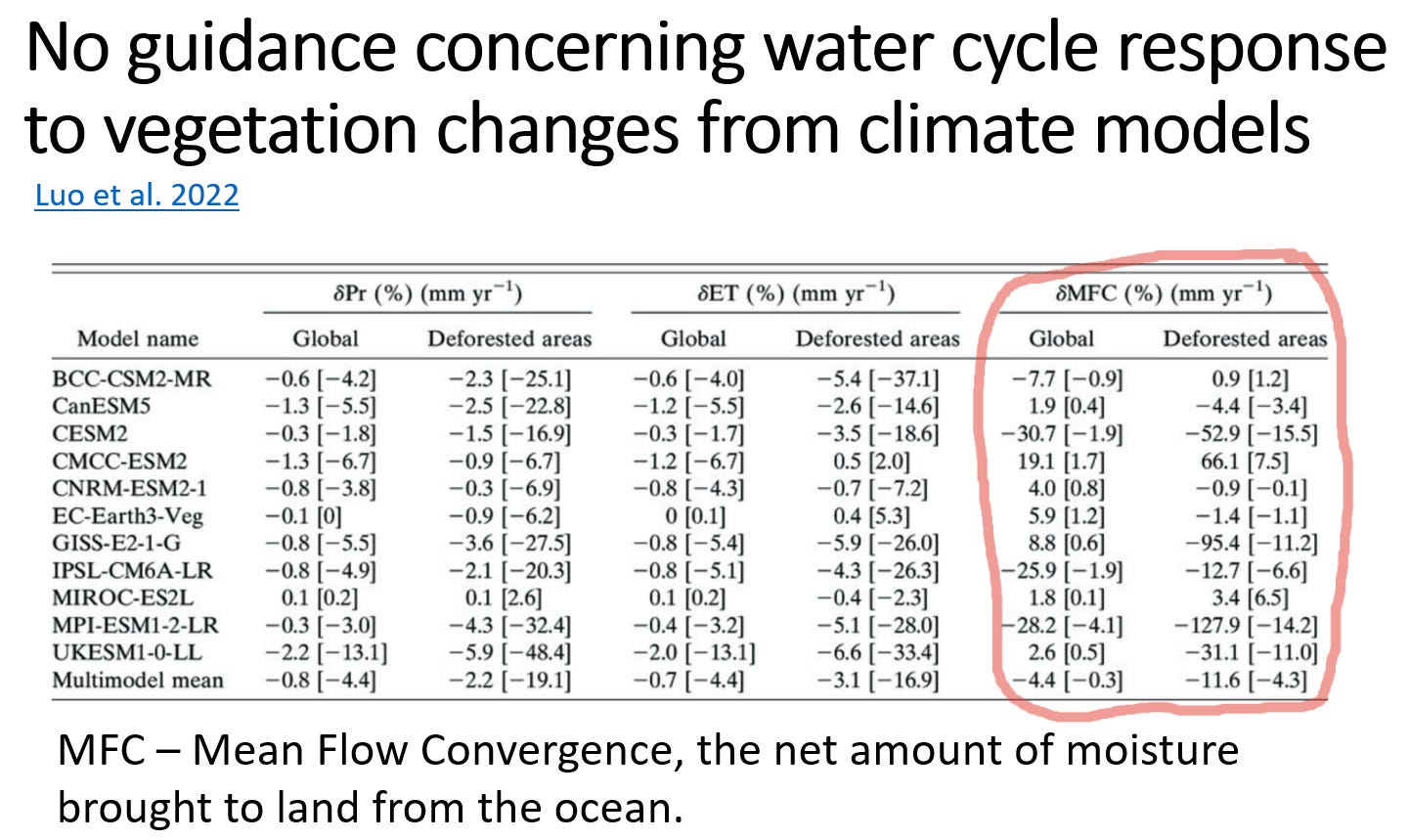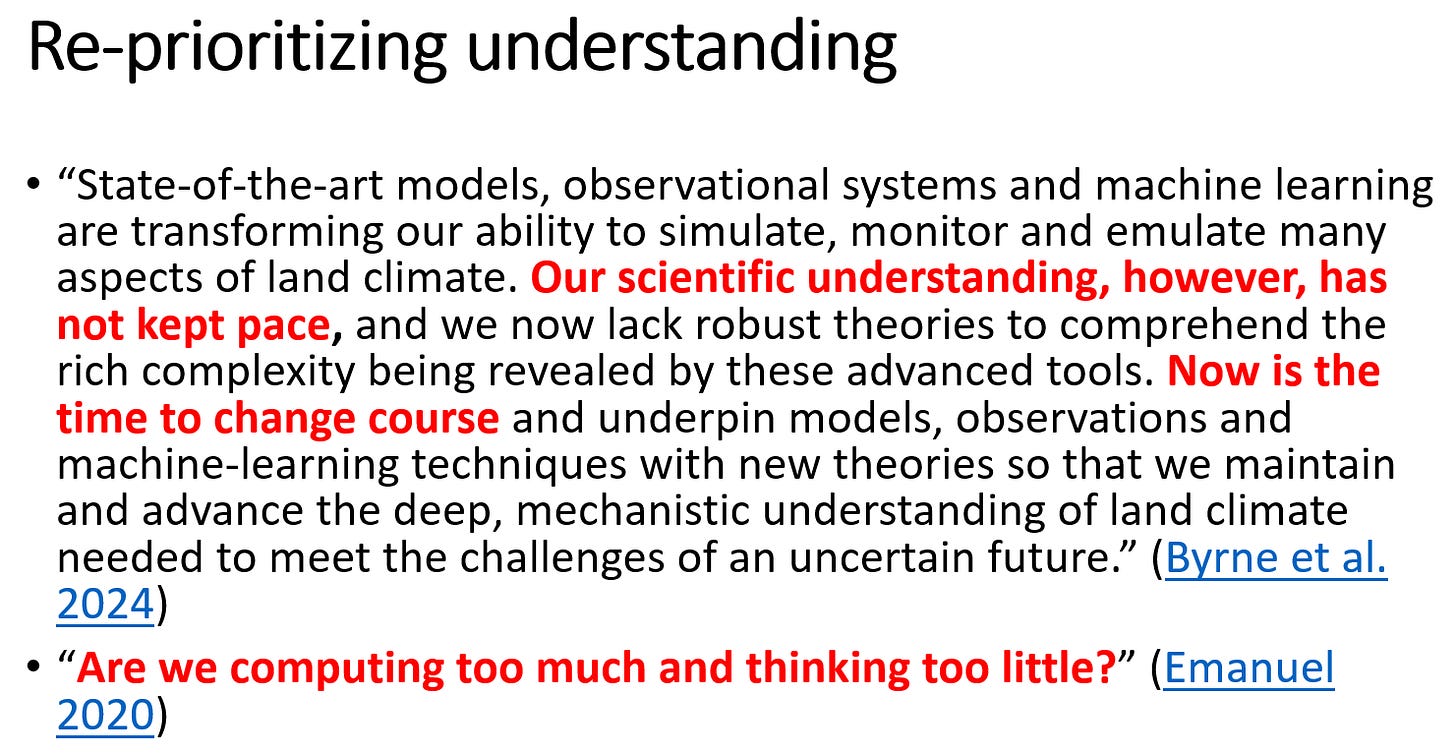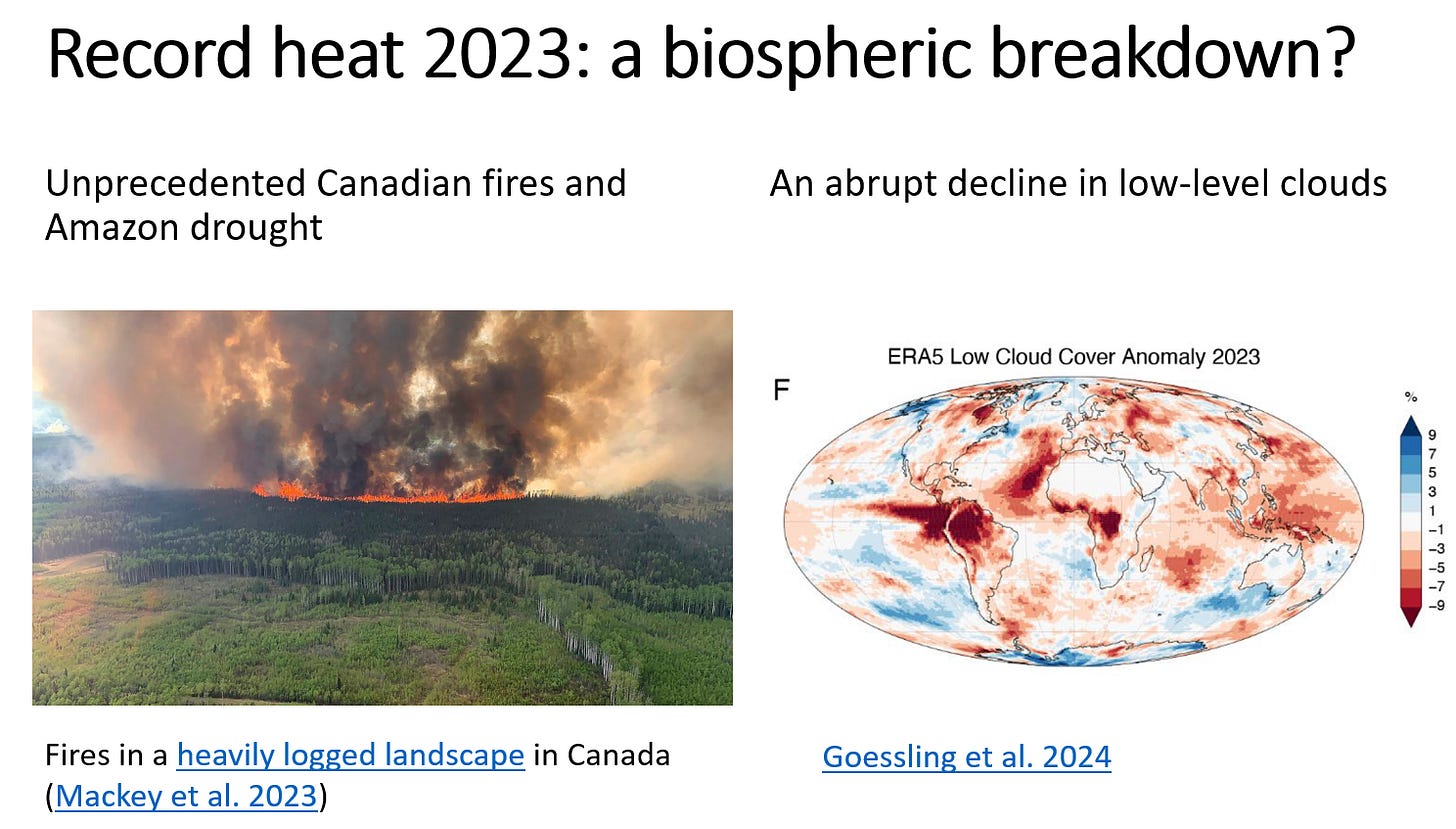Today I had been planning on publishing my piece on what I call The Anomaly of the 2023 Global Heat Anomaly, but something better came along, a presentation by Anastassia Makarieva to the Center for International Forestry Research (CIFOR) called Forests, Water, and Climate: Time for Re-Conceptualization. She has some pretty profound things to say here, such as: Climate science is at a crossroads, with a rare opportunity to shift its trajectory toward a more biosphere-oriented approach.
Have a read. You can also go directly to her Substack page for the same text as well as her video presentation. But I’d recommend reading first, as there is a lot to take in.
First of all, I must say that it is a great honour for me to speak at this conference and to share my views with people who I know deeply acknowledge the existential importance of forests.
We're meeting at a time when not only the global mean surface temperature has reached a new high, but also the rate of the warming has been rapidly increasing. While Douglas was talking about water availability and regional perspectives on how important water is for everybody, I will provide a more global perspective on how forests and water could be relevant in this global context of increasing emergency.
What is essential about the current climate situation is that not only the rate of warming has been increasing – on this graph to the right, you can see the recent trend in the Earth's energy imbalance. It has been increasing. It has actually doubled in recent decades. But what is also important is that climate models are not able to describe it. They're failing to describe this crucial process.
And then we should ask, why do we need to re-focus on forests and water? Why are we having this session today, “Cool forests: Beyond carbon”? From my perspective, this is a recognition of two things. First, that so far we have been largely focusing on carbon. Second, that we have overlooked something very essential.
Our long-term focus on carbon reflected guidance from global climate models that for many years have been the main tool of how we understand climate. These models unambiguously tell us that that forest impacts on climate are negligible if we are talking about anything beyond carbon.
You can see here a figure from a major report and these yellow marks indicate the non-carbon forest contribution to the global temperature change. It is at best a few percent of what’s really going on. We are now talking about a 1.5-degree-Kelvin warming that happened in the last century, while models say that deforestation beyond carbon could have contributed one tenth of a degree at most (and this would likely be cooling).
If the models were doing fine describing climate, and as they are telling us that forests don't matter except as stores of carbon, we could hardly argue for focusing more on water and its role in climate. But the models are not doing fine.
What I want to show you here is a compilation of how different global climate models predict response to deforestation in terms of how much of water vapor will be transported from the ocean. You can see that not only the magnitude of the response differs by more than an order of magnitude across models, but even the sign is not predicted. In other words, we can't know from models what happens to the water cycle if we deforest land. They don't provide any guidance. There is no robust response.
Accordingly, there is a growing recognition in the scientific community that models alone may not be a trusted source of guidance concerning the climate. Here you can see quotes from high profile scientists who draw attention to the fact that our understanding of what's going on, of the key processes behind climate change, has been lagging behind formal numerical modelling.
We're at the point of re-prioritizing understanding from first principles supported by empirical evidence. Analysis of multidisciplinary evidence requires clear theoretical concepts and thinking frameworks.
From my perspective, one of such unifying concepts could be the idea of natural ecosystems, primarily forests that are the most productive ecosystems, serving as climate stabilizers. Their loss in the course of land use and land cover change as well as in the course of oceanic exploitation, if we are talking about the ecosystems of the ocean, has become a major driver of climate destabilization.
Here we are talking not just about global warming but about destabilization in the broader sense, including the increasing frequency of droughts, floods and other water related cataclysms and long-term trends like soil moisture loss.
Now let me show very schematically how the forest can enter the current vision of global warming. This is the hardcore physics part of my talk, so please bear with me for a moment; it will be just for a few minutes.
In this graph to the right, you can see how air temperature depends on height in the atmosphere of the Earth.
In the steady state, the Earth receives as much energy from the Sun as it releases back to space.
The heat released from the Earth to space comes from the upper radiating layer, which you can think of as where the greenhouse gases molecules sit that radiate directly to space. Nobody catches this radiation and nobody resends it back to the Earth.
The higher the temperature of this layer, the more heat it will release.
When we add more greenhouse substances, this layer goes up. It goes up and becomes colder. At this point the Earth releases less energy than it receives and it begins to warm. This warming goes to the surface through this red line, which is the how temperature declines with height.
The slope of this red line shows how fast the air temperature declines with height. We have warming until the temperature of this upper radiative layer is again equal to the equilibrium temperature.
This is the classical conventional view of the greenhouse effect, which describes the impact of the increasing CO2.
Now going to the central scheme, we have clouds. What do clouds do? Clouds reflect more sunlight, so they change the equilibrium temperature of this upper layer. Even if we don't change the height of this layer from which the radiation goes to space, still we can change the surface temperature by reflecting more sunlight.
If there are forests and they're making clouds, then the temperature is lower and their surfaces are cooler. And if we remove forests and remove clouds, there is more sunlight absorbed and there is warming.
So one thing is clouds.
Second thing, you can see from the geometry that we not only can move this line, the grey one, not only can we move the blue one, but we can also move the red line, which is how the temperature changes with height when there is transpiration.
Forests capture a certain part of solar energy at the surface in the form of what is called latent heat. This latent heat is then released during condensation higher in the troposphere from where it later goes unimpeded to space.
Thus by transpiration forests smooth the temperature lapse rate and thus cause cooling. If we reduce transpiration, then more heat remains at the surface, the temperature lapse rate becomes steeper, and we have warming.
Both effects (of transpiration and clouds) will be global and both effects will involve how forests handle water.
Now let me show that both effects are very real and significant.
First, if we are looking at clouds, we have evidence that the record heat in 2023 could have been facilitated by a biospheric breakdown, because we know that in this year the Amazon suffered an unprecedented drought and there were unprecedented forest fires in Canada. In both cases, transpiration and cloud formation were drastically reduced.
We can see that cloud cover was reduced over the Amazon and the adjacent oceanic regions. There is an additional hotspot of cloud reduction over Canada.
This is backed up by our knowledge of how efficient forests are in generating low level clouds that cool the earth. We can see that the the more productive forests are, the more efficient they are in generating clouds. While when we change them for non-forest systems the generation of cloud cover is drastically reduced.
Now regarding transpiration and the role of atmospheric moisture transport. Here again we can see that energy captured as latent heat through transpiration at the surface goes up to the atmosphere and is released to space from the upper atmosphere.
A new biotic pump film from Ray Asselin is available on Youtube
But this process does take time. If there is a long-range regular flow of moist air from the ocean to land and back via the upper atmosphere, this heat has time to be released and thus cools the Earth.
If we deforest and disrupt this long-range moisture transport, and this is what we find in observations, precipitation will be more rigorous over the deforested areas, but only locally. These more rigorous upward and downward motions will be so rapid that the heat won’t have time to be released to space from the upper atmosphere and it will return to the surface with the downdrafts. This will cause an increase in the temperature lapse rate and cause global warming.
As we showed in a recent study, the models don't capture this effect, and the trend in lapse rate is indeed unexplained and it is very significant, especially over land. Thus, there are strong lines of evidence that when we deforest and when we disrupt the moisture flows associated with transpiration, this produces globally significant effects.
From these more specific examples, I want to get closer to the conclusions and to the more general concepts generally for these biospheric climate regulating processes.
Forests require water to function, and the capacity of forests to manage its water balance naturally declines when we begin to disturb them – by logging, burning or disturbing them in some other ways. This leads to climate destabilization through disruption in the water cycle, which can be incorporated into the global change narrative using the notion of climate sensitivity.
Climate sensitivity describes how much the planet warms if the CO2 concentration doubles. This can be calculated from models and the models differ greatly in these estimates. [You can read more about how different models describe climate sensitivity in this post.]
In the current narrative, -- this will be the simpler part without formula or anything -- if this guy is CO2 and this is the Earth and this arrow is warming, the more CO2, the more warming. This is how the current narrative has it.
If we include the ecosystems and incorporate the biosphere, we will see that there are different situations: sometimes it is more “difficult” for a given amount of CO2 to warm the planet, and sometimes it is less difficult.
If we destroy forests and remove their climate-regulating potential, we will get more warming and more climate extremes for the same CO2 addition.
In the current narrative, we focus on decarbonization, while biodiversity and forests are a minor thing which we only consider as something of secondary importance.
In the narrative that incorporates the biosphere, our key strategy is to preserve ecosystems to decrease climate sensitivity to CO2 accumulation. The more forests, functional forests, self-regenerating forests we have, the more stable our climate. [Further reading: “Natural ecosystems and climate stabilization”]
Conversely, the more we take from the ecosystem, the fewer resources it has to buffer climate extremes.
If we saw this 2023 anomaly after a drought in the Amazon forest that was mercilessly plundered, especially during the Bolsonaro times with increasing logging and burning, then now if we have this large-scale deforestation project in Indonesia (MIFEE), we are explicitly asking for more acute global warming.
Ironically, these terrible developments are facilitated by the carbon-focused narrative. Much of the argumentation behind this huge deforestation project in Indonesia is that they will have green fuel, like a renewable fuel, but instead this will actually destabilize our planet even further.
The conclusions would be that it so happened that the evidence that we now have shows that climate science is in need of conceptual rethinking and that there is a rare opportunity that its trajectory moves towards recognizing a greater role of the biosphere.
And we need to know this, how imperfect the models are and not be afraid of bringing evidence from different fields of knowledge, which people working on the ground often get, and not afraid of talking about it because the models are currently failing very spectacularly.
Natural forests buffer the climate by regulating atmospheric humidity, moisture transport and cloud formation. It is crucial to stand up scientifically against large-scale deforestation projects.
Also because, and it is another thing I want to mention, if we don't raise the importance of forests in the global climate agenda, we can't hope that any funding that currently goes to climate issues will go to the forests.
If we demonstrate that forests are crucial players, this may totally change the flow of funds towards their preservation and restoration. Currently, the widely spread argumentation that I showed in the very beginning, that they are not contributing anything to climate except being a carbon storage, is depriving the forest topic of any significant funding, including research funding.
Meanwhile, environmental stability provided by natural forests will support long term economic planning and protect investments, especially in the long term. I think that international and interdisciplinary collaboration need some clear concepts, some unifying ideas. Probably, forests as climate stabilizers could be one.
Conclusions
•Climate science is at a crossroads, with a rare opportunity to shift its trajectory toward a more biosphere-oriented approach.
•Natural forests buffer the climate by regulating atmospheric humidity, moisture transport and cloud formation.
•Standing up scientifically against large-scale deforestation projects is challenging due to political and economic pressures — but absolutely essential.
•The environmental stability provided by natural forests supports economic planning and protects long-term investments.
•International and interdisciplinary collaboration needs big unifying ideas — forests as climate stabilizers could be one.
Thank you very much and you can download my presentation from https://bioticregulation.ru/cifor2025.pdf. It contains references to all publications that I have referred to.
Thanks for reading! I’m glad you’re here. I keep this page free for all but still depend on reader-generosity to make this work possible. Please become a paid subscriber if you can and don’t forget to hit the share button.














Agree, Rob. I thought Anastassia's presentation was excellent. It was one of the easier to understand for this non-scientist and I found it filled with important and relevant info.
Wow, just wow! I wish I could absorb this information as well as Herb would have if he was still here. Excellent stuff, Rob!❤️